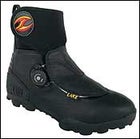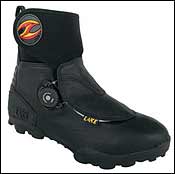Two things are really, really hard to keep warm when cycling in sub-freezing weather: your nose and your toes. Fingers are up there too, but a good combination of glove layers (silk or synthetic liners with overgloves) usually works.
 MXZ301
MXZ301
But a few companies do indeed make winter-specific cycling shoes, albeit expensive. One example is the Lake MXZ301 ($250; www.lakecycling.com), a high-top shoe with layers of neoprene, temperature-regulating Outlast fabric, and water-resistant Pittards leather to keep your feet dry and warm below zero (usually). It’s designed to be a winter mountain-biking shoe, but could work on any road bike with the appropriate pedals, such as Crank Brothers Eggbeaters or Shimano SPDs.
Sidi’s Storm 3 Lorica ($230; www.sidiusa.com) is very similar, with a high-top design, neoprene cuff, and Outlast lining. It uses synthetic Lorica leather rather than Pittards but, like the Lake shoe, can handle most standard mountain cleats. Either shoe should handle temps down to, or even below, zero degrees Fahrenheit.
It’s also possible to winterize road shoes to a surprising degree. Ideally leave enough room inside for a pair of SmartWool socks ($15; www.smartwool.com) and Windstopper oversocks ($40 from Performance; www.performancebike.com). Then, add a pair of good-quality overbootsPearl Izumi’s AmFIB-fabric shoe covers ($50; www.pearlizumi.com) are ideal. I would submit that combo is good into the teens.
Check out ���ϳԹ���‘s for more top road- and mountain-biking gear.


